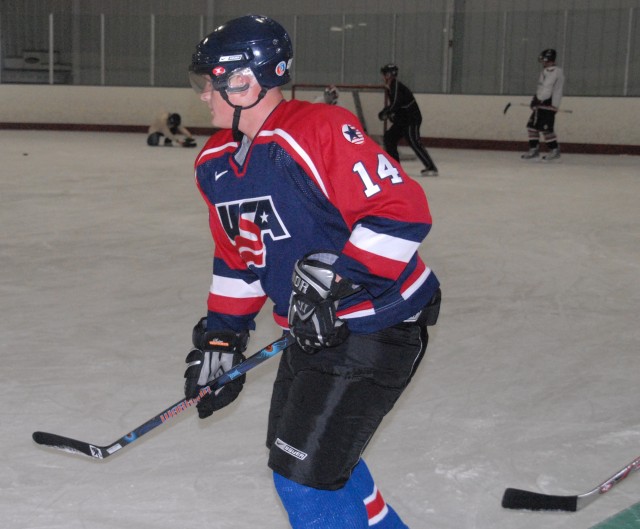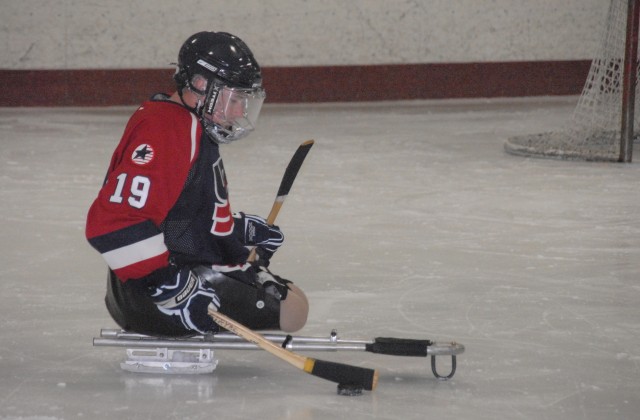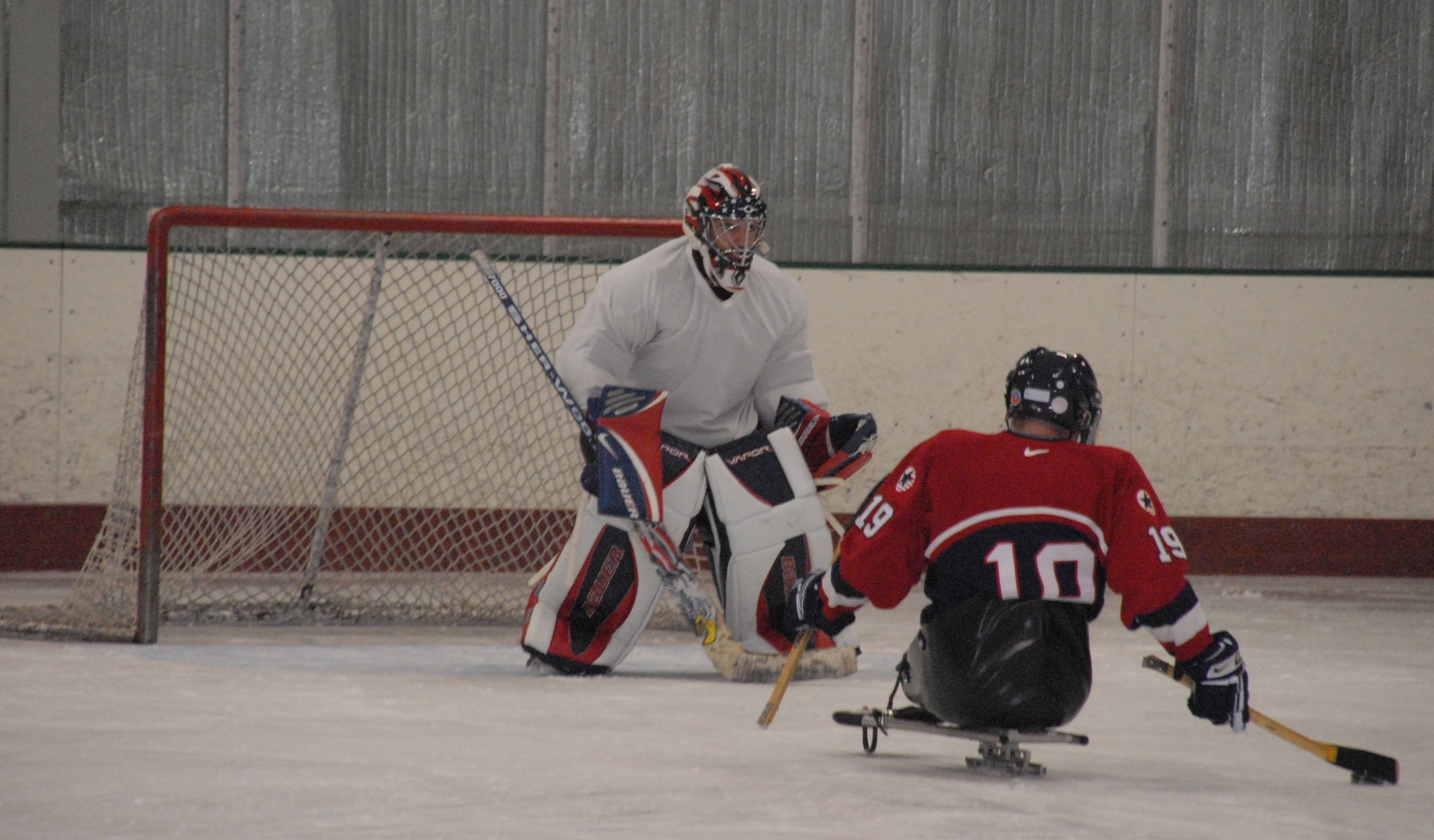LAUREL, Md. (Army News Service, Aug. 25, 2008) - In full hockey gear and padding, retired Sgt. 1st Class Joseph Bowser's prosthesis is not noticeable to the casual observer. He and a number of other amputees look and skate like able-bodied players.
Soldiers say the USA Warriors Ice Hockey Program is the highlight of their week. It was formed about three months ago to give wounded servicemembers an opportunity to get out of Walter Reed Army Medical Center, Bethesda Naval Medical Center and other facilities. They can forget about their injuries and just be athletes every Saturday at the Gardens Ice House in Laurel, Md.
"It shows the guys at all levels that you can get out here and do it," said Bowser, who lost a leg in Iraq in 2004. "Even if it's the first time you get your skates on, you come out here and you try.
"We're all here to support each other," Bowser said. "It's almost like a therapy group because we're all here, we all have the love for the game and it doesn't matter what level we are. We help each other out. To me, it's the best therapy going, because I'm out here with guys who are just like me instead of being out there with guys with two legs and no other problems."
Although Bowser is an experienced hockey player, and even made the U.S. Amputee Hockey team last year, it's the first or second time on the ice for many of the Soldiers like Pfc. Phillip W. Clement, who admits that he still isn't sure how to stop once he starts moving on the ice.
He said he loves "just being out with all the other wounded Soldiers. It's fun to be with other people who don't know what they're doing. We're all learning together."
Experienced coaches like retired Col. Bob Atkinson are on hand to make sure the servicemembers -- who may be amputees like Bowser, sick like Clement or have serious nerve damage -- learn the game and aren't reinjured.
The players must first clear their participation with their physical and occupational therapists, Atkinson said. The coaches also call for frequent breaks and watch carefully to make sure the Soldiers aren't getting too worn out.
He added that one of the first things the coaches learned is that the legs of servicemembers with a certain type of pin prosthesis might turn without their knowledge when they skate.
"A concern we always had was that if they're below-knee amputees, they could badly damage their remaining knee joints or their other knees," Atkinson said of the prosthetics. "So that was something we had to work on quickly, and we're learning too.
"The coaching staff and everybody who works with these folks, we're learning on a medical and physiological side what they can do and emotionally what they can do, which is sometimes way over what we ever expected. Their enthusiasm is way, way over the top. We have to be careful to stop them when it's time to stop. If we don't, they will stay out here all day."
Bowser knows exactly what Atkinson was talking about.
"I remember one time we were out there playing and I caught an edge and I fell down and I couldn't get back up and I asked the guys on the bench if they'd help me up and they said, 'Oh yeah, no problem.' I said, 'Well, before you pick me all the way up, can you take my foot and turn it in a little bit'' They said, 'Oh dude, don't even touch it!' So they thought that I broke my leg. I said, 'It's a prosthetic.' They had no idea."
In full hockey gear and padding, Bowser and many of the other amputees looked like regular hockey players.
They're treated like able-bodied players too. Atkinson said USA Hockey doesn't bend the rules for disabled players. The Soldiers skated, blocked, and turned with the best, and they got back up and started playing again after slipping and sliding on the ice.
Servicemembers who can't stand or balance on skates can play as well, thanks to sled hockey, where players sit on low seats with skates on the bottom and propel themselves using two small hockey sticks. Atkinson said these players need a few rule adjustments, but that otherwise they're also treated like average players.
"You're out here with other guys who are wounded and the ones who will be the hardest on you are the other wounded guys. I'm going to dog him if he's not skating the way he should," said Bowser.
With many of the players still learning hockey basics, the team is still in practice mode and has yet to play a game, but players and coaches say that's the ultimate goal and they can't wait. They'll play against anyone they can, whether kids or able-bodied teams, Bowser said, adding that his real hope is that other Warrior Transition Units will form teams.
Right now, he said there's a sled hockey team at Brooke Army Medical Center in San Antonio that he wants to play.
"It's not what we can't do. It's what we can do," he said, an attitude which inspires Atkinson.
"These are fellow Soldiers for the most part," he said. "Once you're in the military, you don't give up. You're going to stay with these guys and help them. There's an awful lot of satisfaction we get by working with these guys and seeing them progress from week to week.
"They're more than deserving of recognition for what they give up, and any support anybody can give is a big, big thing...I put my skates on probably 20 or 30 times a week and I just don't think about it anymore, but now, every time I come out here with these guys and put my skates on, there's always going to be one or two of them who come back and say just how appreciative they are of what we do for them. It's very humbling. They're appreciative of us putting in an hour out here on the ice rink, but we're appreciative of what they did. Look at how much they gave."






Social Sharing